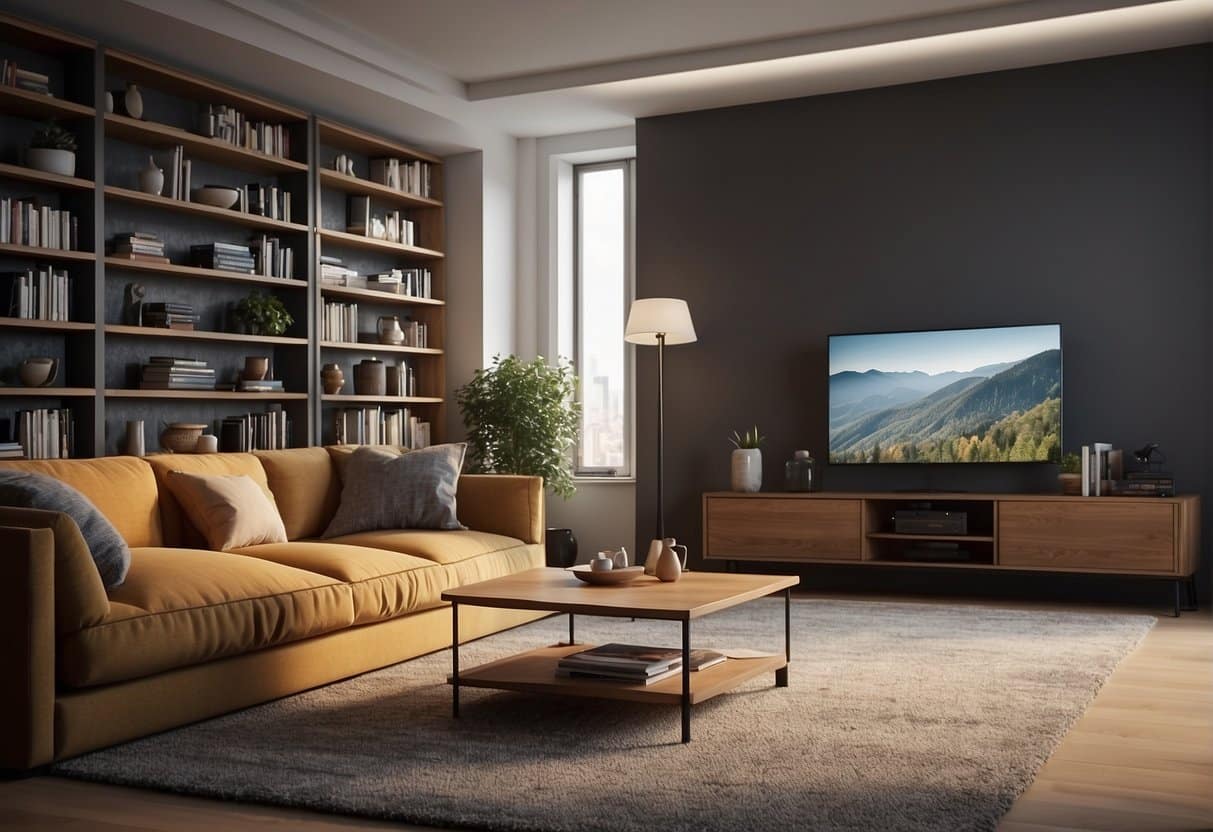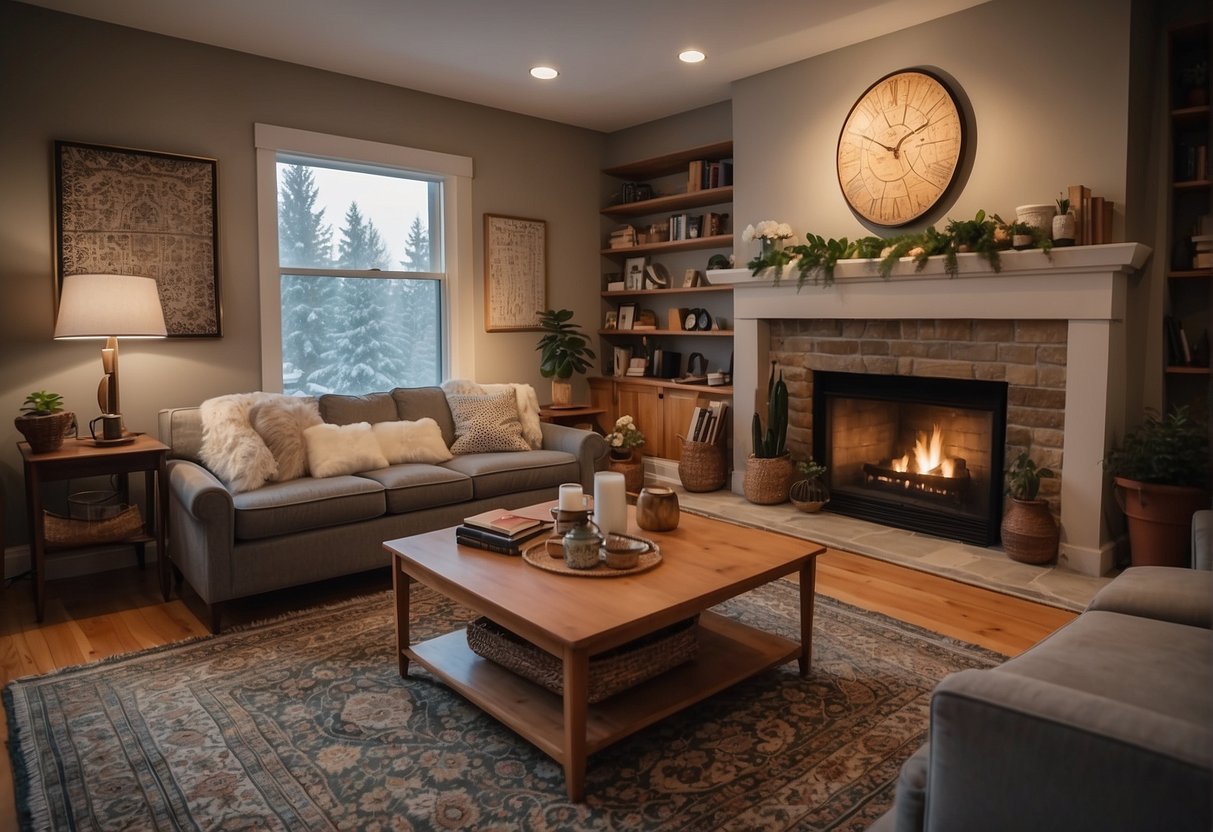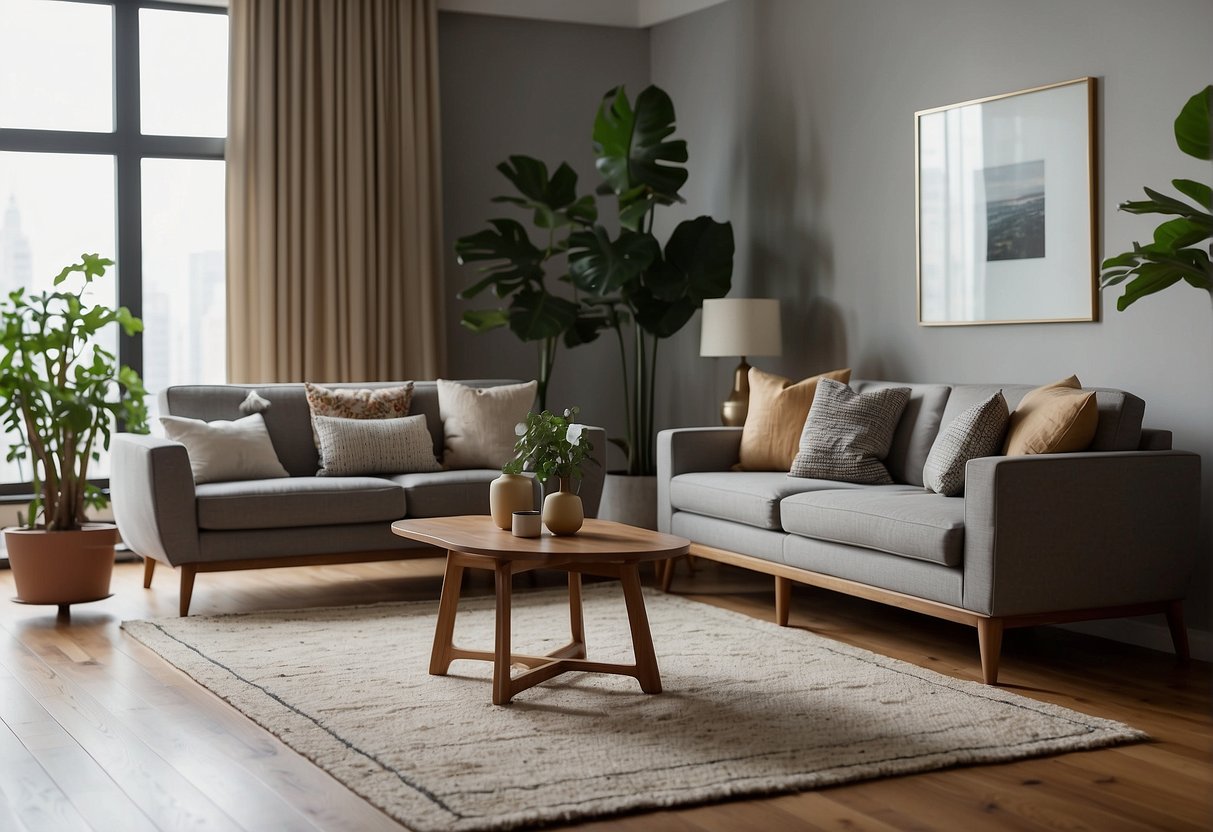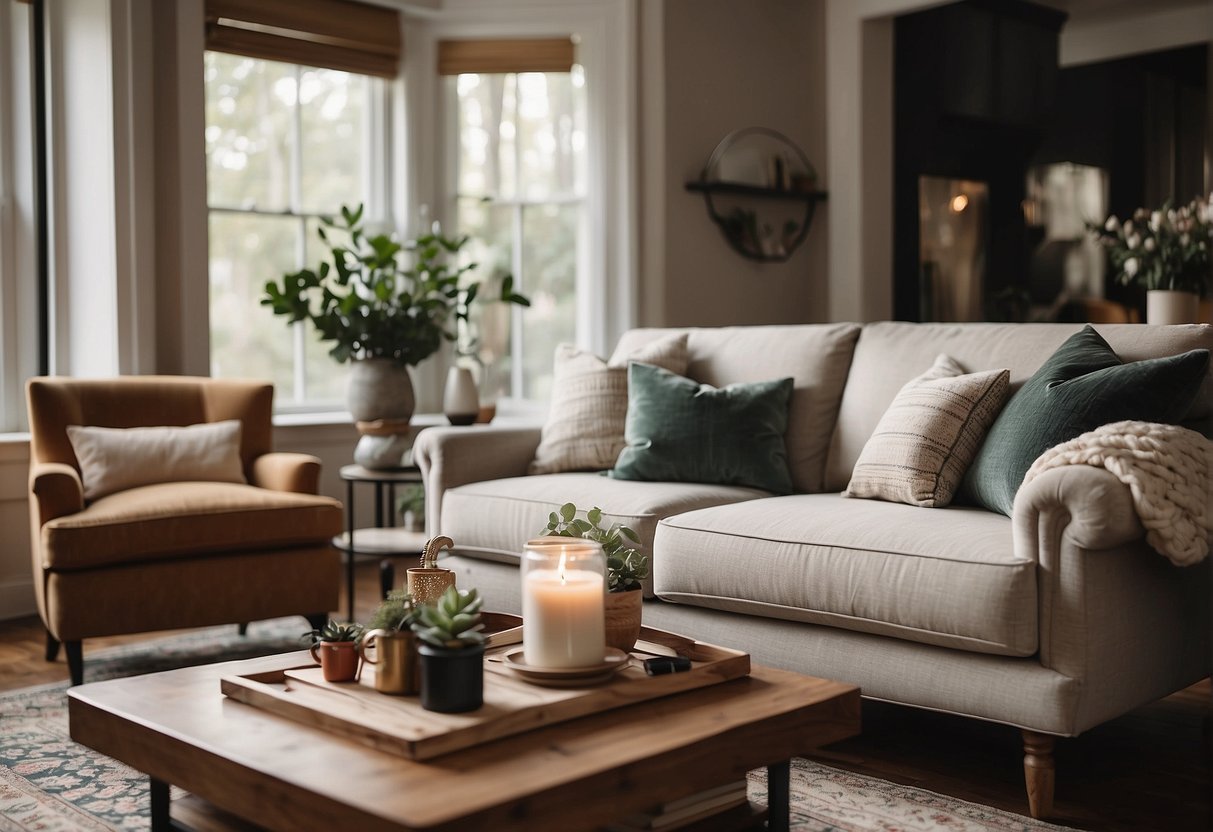
Living Room Furniture Arrangement: Optimize Space and Style
The art of living room furniture arrangement is both functional and aesthetically pleasing. The living room is where people gather to relax, socialize, and entertain, making it a pivotal part of any home. It’s essential to create an inviting space that caters to various activities, whether it’s watching TV, hosting a game night, or simply enjoying a quiet moment with a book.
To achieve the perfect balance between functionality and comfort, one must consider different factors such as furniture pieces, their placement, and the overall aesthetics. Strategic furniture placement can help define and enhance the living area, making the room feel more cohesive and harmonious. Additionally, exploring various layout options and innovations can significantly improve the living room’s overall appeal and adaptability to individual and family needs.
Key Takeaways from Living Room Furniture Arrangement
- Furniture arrangement focuses on balancing aesthetics and functionality in living spaces.
- Strategic placement of key pieces enhances cohesion and visual harmony.
- Exploring different layouts increases overall appeal and adaptability for various activities.
Fundamentals of Furniture Arrangement
Understanding Function and Flow
When arranging living room furniture, it’s important to consider both function and flow. Function refers to how the furniture will be used, while flow refers to the ease of movement through the space. Start by identifying the focal points in your living room, such as a TV and fireplace, and arrange furniture to accommodate these features. Maintain clear paths for traffic flow to ensure that people can comfortably move around the room.
A proper furniture layout should have:
- Adequate seating for the intended number of people
- Good visibility of the focal points (TV, fireplace, etc.)
- Functional traffic patterns
Principles of Balance and Proportion
Next, consider the principles of balance and proportion in your furniture arrangement. Balance refers to the visual weight and distribution of objects within a space to create harmony, while proportion considers the scale and size of furniture in relation to the room dimensions. To achieve balance, ensure that heavy or visual items are evenly distributed across the room.
Here are some guidelines for achieving balance and proportion:
- Size and Scale: Choose furniture that is appropriately sized for the room. Large items in a small space can feel overpowering, while small furniture can make a room feel incomplete and not as comfortable.
- Visual Weight: Pay attention to the distribution of colors and shapes. Darker, bolder pieces should be balanced with lighter, more neutral elements to create a cohesive look.
- Symmetry vs. Asymmetry: A symmetrical arrangement creates a formal, balanced look, while an asymmetrical layout offers a more casual and visually interesting atmosphere. Consider your personal style and the purpose of the space when deciding on the level of symmetry.
By applying the principles of function, flow, balance, and proportion, you can create a living room furniture arrangement that is both comfortable and visually appealing.
Key Living Room Furniture Pieces

Sofas and Sectionals
The primary piece of furniture in any living room is the sofa or sectional. They provide essential seating and anchor the room’s overall design. Sofas come in various sizes and styles, ranging from traditional three-seater sofas to more contemporary L-shaped sectionals. When choosing a sofa, consider factors such as:
- Size: Measure your living room to determine the ideal dimensions.
- Style: Select a design that complements your existing décor.
- Comfort: Test out different materials and cushioning for optimal relaxation.
Chairs and Armchairs
Next, incorporate chairs and armchairs to offer additional seating options and diversify your room’s aesthetic. These pieces can include elegant accent chairs or cozy, oversized armchairs. When selecting chairs, consider the following:
| Type | Best For |
|---|---|
| Accent Chairs | Adding visual interest and occasional seating |
| Armchairs | Comfortable and versatile seating option |
Key factors in choosing chairs and armchairs:
- Style: Opt for pieces that complement or contrast with your sofa design.
- Function: Choose chairs with ergonomic features or unique designs that serve a specific purpose.
- Material: Pick a fabric or leather finish depending on your preferences and room’s design.
Coffee Tables and Side Tables
Lastly, coffee tables and side tables are indispensable additions to a living room. They serve both functional and aesthetic purposes, offering a surface for items like drinks, books, and remote controls. Here’s an overview of each:
- Coffee Tables: Centrally located, the coffee table is a crucial anchor in the living room. Consider factors like size, shape, materials, and additional storage options.
- Side Tables: Perfect for flanking sofas or chairs, side tables provide convenience and versatility while offering an additional display area for lamps, plants, and décor.
In conclusion, the key living room furniture pieces—sofas, sectionals, chairs, armchairs, coffee tables, and side tables—combine function and style to create a harmonious, comfortable, and aesthetically pleasing living space. Prioritize size, style, and material to make informed purchasing decisions that complement your home’s design.
Strategic Furniture Placement

Maximizing Small Spaces
When working with a small space, it’s essential to carefully consider furniture placement. Opt for multifunctional, smaller-sized furniture to maximize the area, and avoid clutter. A smart technique is to utilize wall space for storage and organization. To create the illusion of more space, consider incorporating mirrors in the room.
Arranging for Large Rooms
Large rooms can be equally as challenging when it comes to furniture arrangement. To create a cozy atmosphere, break the space into smaller, more intimate areas. Use large furniture pieces to define these areas and consider adding area rugs for added comfort. A helpful tip is to arrange seating in a way that encourages conversation, such as arranging sofas and chairs facing each other.
Incorporating Focal Points
A focal point is a central element in any room that draws the eye and sets the overall tone. To effectively incorporate focal points into your living room furniture arrangement, start by identifying the main feature of the room. This could be a fireplace, artwork, or a large window with a view. Arrange furniture around this focal point to create a harmonious and visually balanced space. For more inspiration on living room layouts that make the most of your gathering space, explore a variety of concepts and ideas online.
With these strategic furniture placement tips, you can create a delightful and functional living room environment that caters to various preferences and needs.
Enhancing Living Room Aesthetics

Influence of Lighting
Lighting plays a crucial role in showcasing the potential of any living room. To emphasize the visual appeal, one must strategically choose the right type of lighting, such as floor lamps, table lamps, and other ambient sources.
- Floor lamps: These tall, standing lights provide a cozy atmosphere, especially when placed near a sofa or armchair.
- Table lamps: Smaller, more portable lamps are excellent for decorating side tables and creating ambiances in various spots throughout the room.
The brightness level and direction should also be adjustable to cater to any preferences or activities that occur within the living space.
Integrating Art and Wall Decor
Artwork and wall decor can elevate the aesthetics of a living room significantly. Choosing the right pieces and placements can have a considerable impact. Here are some tips for integrating both:
- Keep it balanced: Ensure that the visual weight of artwork or decor is evenly distributed throughout the room.
- Create the right focal point: Position a large or bold piece in a prominent location to draw the eye.
- Try a gallery wall: If the space boasts a more eclectic style, consider an arrangement of multiple works to create an engaging gallery wall.
Choosing the Right Area Rug
Selecting the appropriate area rug contributes to the overall appearance and comfort of the living space. When making a decision with such impact, one must consider key factors like size, color, and material.
- Size: Select a rug large enough to accommodate all furniture, or at least the front legs of each piece.
- Color: Opt for a carpet that complements the existing color scheme, or use it as an accent piece.
- Material: Consider the room’s traffic, durability needs, and cleaning requirements to select the appropriate rug fabric.
By carefully considering these aspects of lighting, artwork, and area rugs, homeowners can create an aesthetically pleasing and cohesive living room environment.
Functionality and Comfort
Creating Conversation Areas
A functional living room should prioritize creating a cozy conversation area. To achieve this, arrange the main seating furniture, such as sofas, armchairs, and benches, in a way that encourages face-to-face interaction. For instance, you can place two sofas facing each other, with a coffee table in between. Be sure the distance between the seating is about 8 feet apart for optimal conversation quality.
Adding a few accent chairs might also provide additional seating options, giving guests the freedom to move around and join conversations within different groups. Moreover, utilize area rugs to define each conversation area, making the space look more inviting and aesthetically pleasing.
Optimizing Seating Options
When it comes to optimizing seating options, variety and flexibility are key. Design your living room with a combination of oversized sofas, armchairs, and accent chairs to accommodate various numbers of guests. Keep in mind the room’s dimensions when selecting different seating options, ensuring the proper fit without overcrowding.
- Offer a mix of seating types, such as comfortable armchairs and stylish accent chairs.
- Use modular furniture for flexibility in rearranging the furniture according to your needs.
- Add a few stackable chairs or foldable seats for easy storage when not in use.
Utilizing Vertical and Storage Spaces
Lastly, a functional living room should make the most of vertical and storage spaces. Incorporate built-in shelves and wall-mounted cabinets to keep your belongings organized and free up floor space. This not only adds functionality but also enhances the overall aesthetics of the space. For added storage, consider using furniture pieces that double as storage units, such as ottomans and coffee tables with hidden compartments.
A well-planned living room will combine functionality and comfort to create an inviting atmosphere perfect for gatherings and relaxation. By implementing these simple yet effective design principles, you can transform your living room into a welcoming, accommodating, and comfortable space for everyone to enjoy.
Layout Variations and Innovations
Open-Concept Living Room Ideas
Open-concept living rooms create a seamless flow between the living and dining spaces, making the area feel larger and more inviting. This type of layout is especially suitable for small living rooms, as it maximizes the available floor area. One way to approach an open-concept layout is to use furniture to divide the space visually. A low-profile sofa or bookcase can serve as a partition between the living and dining areas, while still allowing for an open feel. For more ideas on open-concept living room layouts, check out these Living Room Layout Ideas.
Designs for Multipurpose Spaces
In today’s modern homes, multipurpose spaces are becoming more common. These areas can serve as a living room, dining space, and even a home office, given the right layout and furniture choices. When designing a multipurpose living room, consider incorporating versatile furniture pieces that can serve multiple functions, such as a dining table that can also be used as a workspace. Additionally, modular sofas or storage units can be rearranged to suit the changing needs of the space, making it easy to switch between functions.
| Furniture Piece | Functions |
|---|---|
| Convertible sofa | Seating, sleeping |
| Dining table | Dining, workspace |
| Modular storage units | Storage, room dividers |
Symmetrical versus Asymmetrical Layouts
The choice between a symmetrical or asymmetrical layout can significantly impact the overall aesthetics and functionality of a living room. In a symmetrical layout, furniture is arranged in a balanced and mirror-image pattern, creating a sense of order and stability. This type of layout is often used in formal settings and can make a room feel more elegant and sophisticated.
On the other hand, an asymmetrical layout features a more relaxed and casual arrangement of furniture and decor. This approach allows for greater flexibility in placement and can be especially appropriate for small living room layouts, where space may be limited. By incorporating dynamic elements such as different-sized furniture pieces, varying heights of artwork, or contrasting colors and textures, an asymmetrical layout can create visual interest and a sense of movement within the space.
In conclusion, each layout type has its pros and cons, and the choice ultimately depends on the homeowner’s preferences and the specific requirements of their living space.
Final Thoughts on Living Room Furniture Arrangement
When arranging furniture in a living room, it’s important to keep functionality and aesthetics in mind. The layout should promote easy conversation and traffic flow while making the space visually appealing. Below are key considerations to achieve an inviting and well-organized living area:
- Focal point: Determine the central element, whether it’s a fireplace, TV, or artwork. Arrange furniture around this focal point to create a cohesive look.
- Seating: Offer various seating options such as sofas, armchairs, and ottomans. Ensure there’s enough space between them for comfortable movement.
- Reuse and repurpose: Use what is already available (like shelves or cabinets) to create new arrangements and storage solutions.
- Color scheme: Coordinate the color of your furniture and décor to support a specific theme or style.
- Rug placement: Make sure rugs are in proportion to the room size and placed correctly under the seating arrangements.
| Section | Tips |
|---|---|
| Focal point | Fireplace, TV, artwork |
| Seating | Sofas, armchairs, ottomans |
| Reuse & repurpose | Shelves, cabinets |
| Color scheme | Themes, styles |
| Rug placement | Proportion, placement |
Incorporating various shapes and materials in your living room furniture arrangements can add visual interest. For instance, consider combining round side tables with rectangular sofas and mixing wood, metal, and glass elements.
Lastly, don’t forget to leave enough space between furniture pieces. This ensures proper traffic flow and creates a sense of openness in your living area. Experiment with different layouts until you find one that works best for your space and lifestyle.
Luxury Specialist at McGraw Realtors
With a diverse background, including a career as an Air Force fighter pilot and entrepreneurship, Bill transitioned to real estate in 1995. Co-founding Paradigm Realty with his wife, Charlene, he quickly rose to prominence in Oklahoma City’s luxury real estate scene. Now, as one of the top agents with annual sales surpassing $20 million, Bill’s dedication to exceptional service remains unparalleled. With a legacy spanning over two decades in the industry, Bill’s expertise and commitment make him a trusted name in luxury real estate.